March 31, 2011
General Links
2011 Frontpages & Stays
2010 Fronpages & Stays
2009 Frontpages & Stays
2008 Front Pages
2007 Front Pages
2006 Front Pages
- 2006.12.12
- 2006.11.21
- 2006.11.04
- 2006.10.23
- 2006.10.09
- 2006.09.26
- 2006.09.10
- 2006.07.15
- 2006.05.30
- 2006.01.01
2005 Front Pages
2004 Front Pages
2003 Front Pages
2002 Front Pages
2001 Front Pages
2000 Front Pages
1999 Front Pages
Country Links
Click on flag for Foto Show; click on country name for text and photographs.
Asia
 Cambodia
Cambodia
 China
China
 Beijing
Beijing
 Hong Kong
Hong Kong
 Indonesia
Indonesia
 Japan
Japan
 Laos
Laos
 Malaysia
Malaysia
 Singapore
Singapore
 Thailand
Thailand
 Tokyo
Tokyo
 Vietnam
Vietnam
Pre 1999 Asian Visits
Europe
 Austria
Austria
 Athens
Athens
 Basel
Basel
 Britain
Britain
 Berlin
Berlin
 Bratislava
Bratislava
 Belgium
Belgium
 Brussels
Brussels
 Bulgaria
Bulgaria
 France
France
 Germany
Germany
 Greece
Greece
 Italy
Italy
 Moscow
Moscow
 Paris
Paris
 Poland
Poland
 Prague
Prague
 Romania
Romania
 Russia
Russia
 Switzerland
Switzerland
 Ukraine
Ukraine
 Vienna
Vienna
Americas
 Belize
Belize
 Colombia
Colombia
 Costa Rica
Costa Rica
 Ecuador
Ecuador
 Guatemala
Guatemala
 Honduras
Honduras
 Mexico
Mexico
 Nicaragua
Nicaragua
 Panama
Panama
USA
Vancouver
Middle East - Africa
 Egypt
Egypt
 Israel
Israel
 Morocco
Morocco
 Turkey
Turkey
 South Africa
South Africa
Australia - New Zealand
 Australia
Australia
 Christchurch
Christchurch
 New Zealand
New Zealand
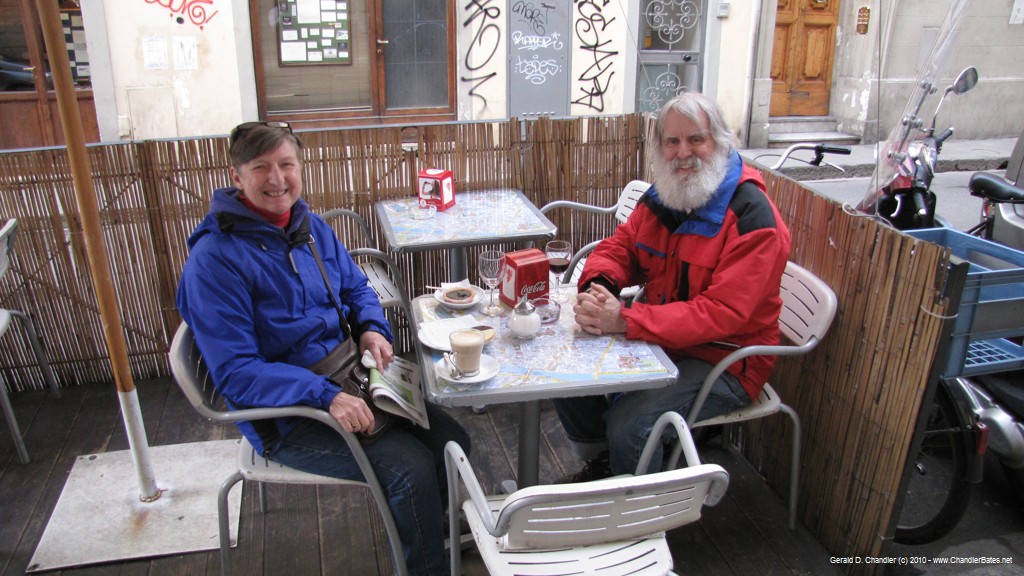
Eating in a Florence side-walk(?) cafe |

Piazza of the Amfiteatro, Lucca |
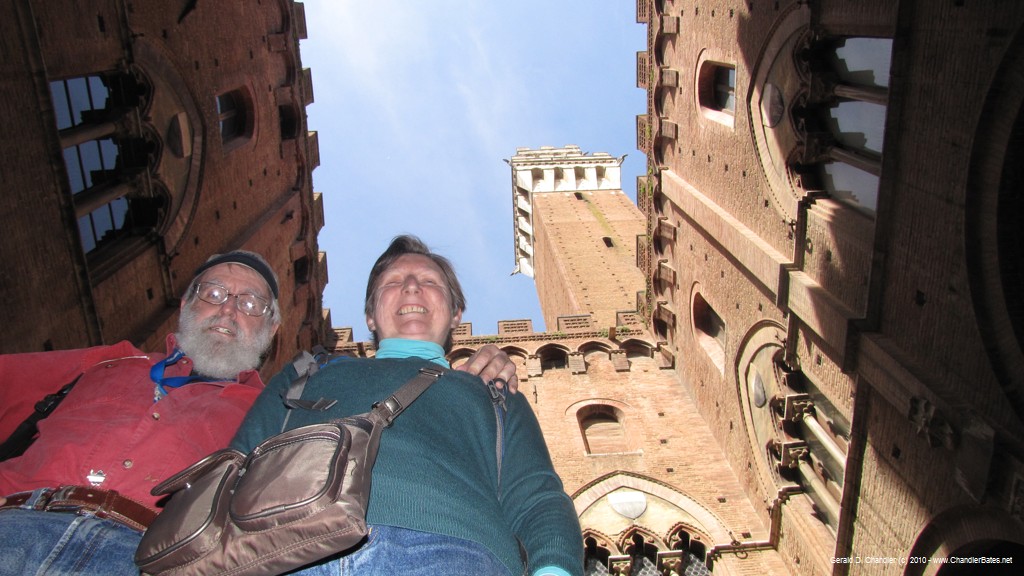
Mangia Tower, Siena |
By delaying a bit for this posting we can now inform our dedicated readers that we've seen all the really famous places in Florence. Of course, after just under three months here we've also seen plenty of relatively minor places. But a few days ago we went to the Pitti Palace and saw the 15th-19th century art and the state apartments there and that completed the list of the greats. On our Florence page we'll describe in detail what we've seen in this city that can't help but worm its way into your heart. Here let us say that we've seen all the great churches, all the great palazzos, and been down most, if not all the little streets. In addition we have made two one-day trips, to Lucca and Siena, each very, very interesting. We'll soon extend this to Pisa and San Gimignano.
Click on any photo below to see it enlarged. It will appear as part of a slide show of all photos on this page. The image size can be changed by clicking on the plus and minus buttons. In the upper-left corner of a slide show click on either of the small-blue triangles to see another album (sets of photos). One of the albums is of us in Florence in January-February. Two more show us in New Zealand last year and us in Tokyo even earlier in 2010.

Yvonne, Jan, and Sandro on Ponte Vecchio |
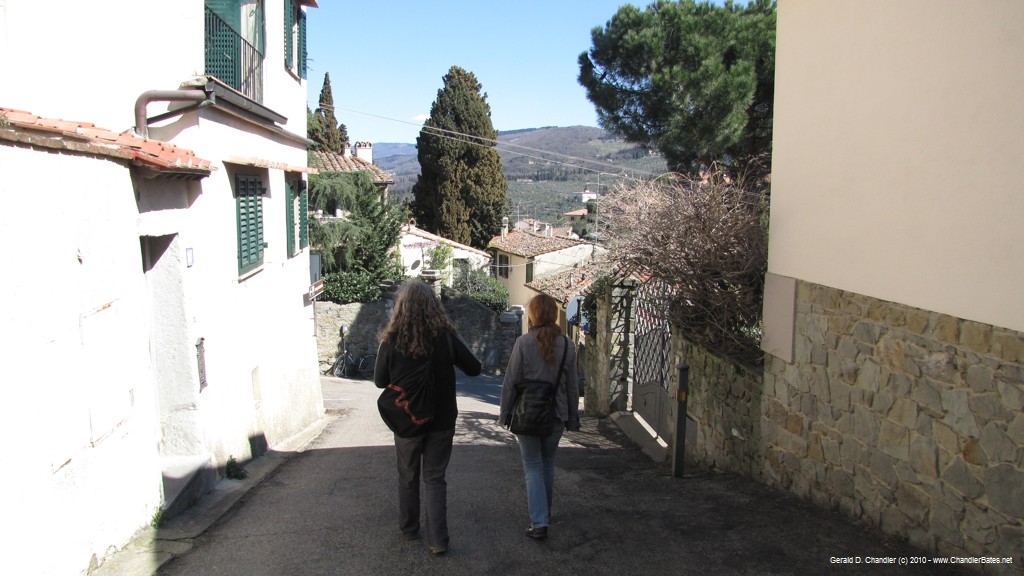
Yvonne and Sandro in Fiesole hills |
Two weeks ago we had our first (and probably last) visitors: Yvonne and Sandro came to stay for four days. They're from Switzerland, though we met them seven years ago in Creel, Mexico and have stayed in touch. Their coming forced us to think about what are the essentials to a visit to Florence? We'll have had almost four months when we leave. What should one do when just four days are available? Of course everybody is different but still, Florence is Florence, and if you come to see Florence it is to see what it is all about. That, of course, is the birth of the Renaissance and the art and churches and palaces that go with it. Our time here has allowed us to develop personal preferences and understand things “under the skin” in a way that is impossible only reading a guide book. We recommended to them that the first day they just walk about and get a real feel for the streets; the second and third day could be spent at two great palace-museums ( Palazzo Vecchio and the Bargello) in the morning and at two great churches ( Santa Maria Novella and Santa Croce) in the afternoon. We felt that while the Uffizi and Pitti Palace (the most famous places in Florence after the Cathedral- Bapistery) are great museums they are too overwhelming and so crammed with things that one's head must suffer from trying in successive days to master (or even sample) them. On the final day one should go to Fiesole and walk through a place that is closer to the village that Florence used to be.
And that is mostly what Yvonne and Sandro did, but in their way. On the first day when we stopped walking they went on until late. And having seen one great church and palace-museum that was enough; they preferred to walk more and also visited the Mercato Centrale (which we didn't visit until after a month) because they had some shopping in mind. And whereas we took the bus to and from Fiesole they walked all the way back. (It's just six kilometers; Gerry's bad knee kept us from accompanying them.) Actually, the greatest part of our time together was chatting over a meal at our place and in three different cafes facing the sites we'd recommended. Sandro is of Italian background and he introduced us to a couple of breads, cheeses, and cookies that we hadn't tried. Good for him; otherwise we might have missed them. If there was one hitch it was that they felt Gerry mothered them a bit too much but that didn't change that we were very happy to see them.

Ristorante-Pizzeria in Scandicci |
Before we came it wasn't the food that we were looking forward to. Jan has always found Italian food (as experienced elsewhere) overcooked and boring and hasn't been interested in it. Gerry has been more tolerant but that is because he cares less. It hasn't made too much difference to us because we mostly cook for ourselves. We walk to the Coop supermarket and back, about 800 meters each way, buying things that we would eat just about everywhere. Nonetheless we've gradually become acquainted with some additional Italian dishes and the way things are done Italian style. At the supermarket they sell cooked Italian dishes and we've sampled a few, especially liking the Coop way of doing Pork knuckle.
Through luck we've dropped into some neighborhood Italian restaurants, where we've had fine, traditional lunches consisting of a 'primo piatto' (pasta dish), a 'segundo piatto' (meat and vegetable), and wine and bottled water. (They are often called 'Restorante-Pizzeria' and sell as much pizza as full meals.) We skip the dessert and coffee as these two-course meals are pretty filling. That's why we mostly opt for sandwiches from a bakery or bar. One such great meal was in a tiny place in Fiesole, where we had our first taste of chocolate migliefoglie. Even in sidewalk cafes there is an Italian way of making a sandwich. Our mouths still water for the sandwiches we had at a very simple place, with the traffic rushing by almost in our laps, on the edge of the Piazzale Michelangelo.
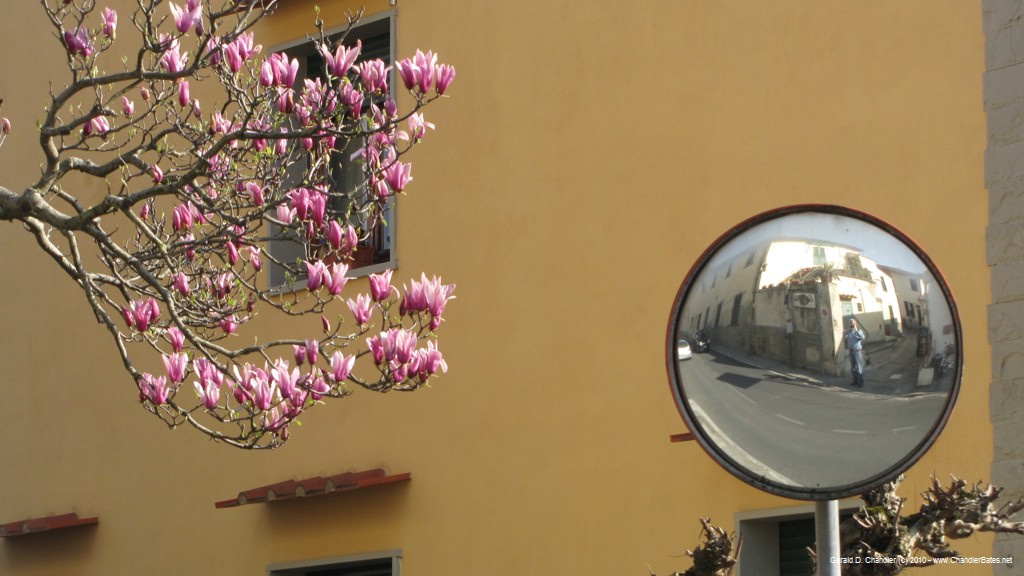
Newly blossoming Magnolia admired by Gerry |
Spring has sprung and almost since the moment the Spring equinox was reached Gerry has been going without a coat. (Jan is still holding on.) When we came to Florence we expected to escape the rigors of winter. Not! Of course we didn't have the deep and frequent snow of Chicago or even the lasting snow of Darlington and London that we experienced in December, but through January and February we had to wear hats and gloves, triple layers on the torso, and, for Jan, tights. At the beginning of March Florence had a retrogression of sorts and became colder than it had been a few weeks earlier. Every night it dropped below freezing and almost every morning we woke up to new snow on the hills that define the Arno valley. But thankfully for a week now we've been able to leave the balcony doors open in the daytime and end the cooped-up feeling. In the back garden the trees are coming to life with their blossoms. As we walk to the bus stop we pass a wonderful magnolia almost into full bloom. Here and there are cherry trees whose new blooms remind us that just a year ago we were in a sea of them from the moment we arrived in Tokyo.
The government must have been confident this warmth would come on time; a few days ago we learned that in Italy it is illegal to heat after March 31. Now the central heating is off and we're back to wearing layers. We'll see how it goes. People tell us that the winter lasted an exceptionally long time and that usually before now it gets warm. We have moved to the position that that is wishfull thinking as we have learned that statistically our late March temperatures were more typical of early May. Maybe we've been very lucky when we thought the opposite!
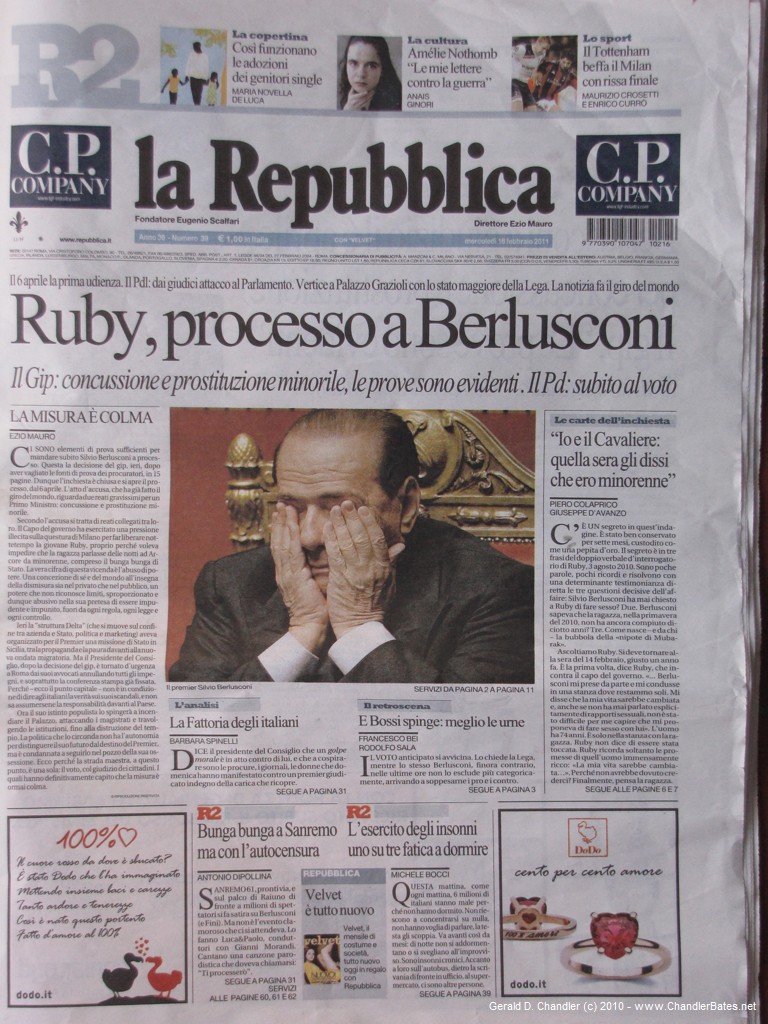
Feb 15: Berlusconi troubled by Ruby |

Feb 17:What will Gaddafi do? |
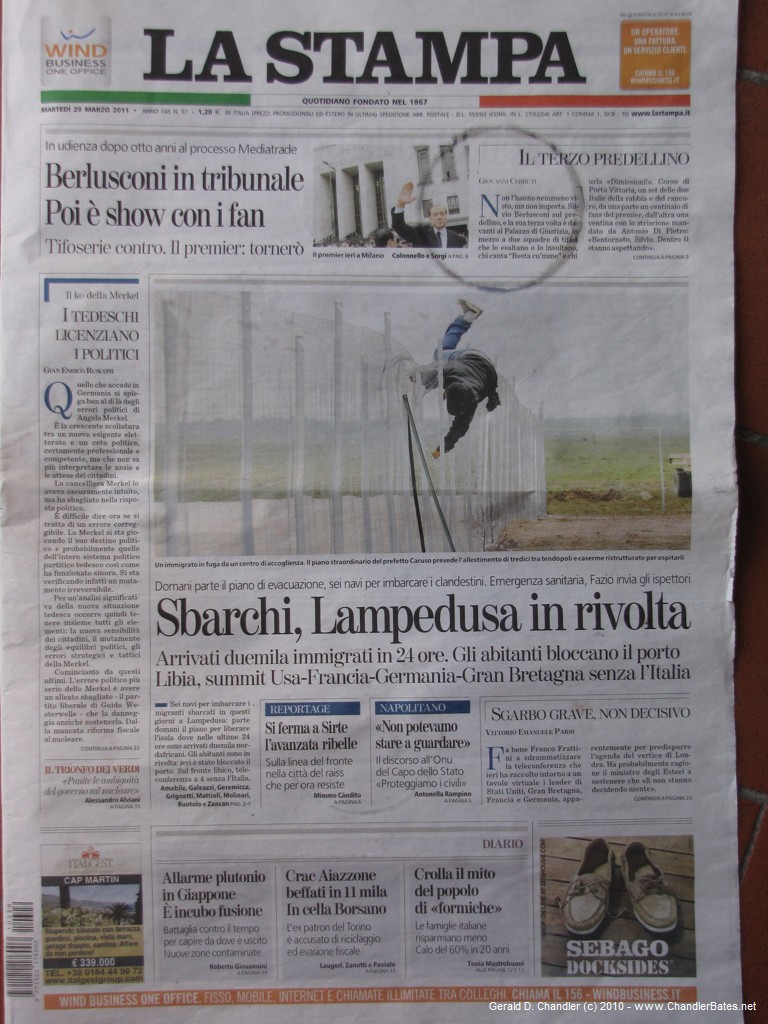
Mar 29: Trouble in Lampedusa |
From the first day here we have tried to follow the Italian news on radio, TV, and in the newspapers. It's a struggle, but we've made progress, with Jan in the lead. Whereas we used to labor through a single newspaper article now we sometimes manage to read three or four articles at a sitting. As we can't get through a paper in one day it's only about every third day that we buy a paper — either La Repubblica, Corriere della Sera, or La Stampa, all national newspapers.
A running story since we've been here is will or won't Berlusconi get done by the law for encouraging underage prostitution, namely by paying under-18 Ruby for sex. One of the networks we watch is owned by Berlusconi's Mediaset; it lets him off easily compared to the government-run Rai2 and its TG2 evening news program. Since the beginning of the Arab Spring there has been massive illegal immigration from Tunisia and that is on the news every night as boat after boat lands at Lampedusa, the southernmost Italian island. We're on the side of upholding immigration laws; as in France and the USA there is quite a divide here about what to do about these economic refugees. Italians often mention the fact that 100 years ago it was Italians who were the migrants as justification for being welcoming to immigrants.
Jan has finished her first book in Italian: L'esilio, the Italian translation of Pearl Buck's biography of her mother in China, The Exile. We receive email in Italian from our landlady and Jan replies in the language of Dante, if not with his poetry. Jan has perhaps reached the equivalent of her level of Chinese, where at one point she could make a hotel reservation over the phone. Now she can ask for a taxi or make a doctor's appointment. We're hopeful that by the end of June we'll be able to read even more and have reasonable conversations in Italian.
Going to sleep and waking up we listen to Italian Radio Uno and try to decipher it. Now often we can, but more often we just get tantalized. In the evening we watch two TV news shows back-to-back, usually seeing the same pictures and, by the second time around, catching a lot of the meaning. That way we've followed, among other events, the February Christchurch earthquake, the March Japanese earthquake and tsunami, and the Arab 'Spring' (with Libya being the current focus of attention). All of these stories have personal interest for us: last year we lived in and now have friends in Christchurch; we have friends in Japan; and we have lived in the Middle East and have friends who've been negatively affected by Middle-east dictators. We're fascinated by the needs for the anti-Bush/anti-War democrats, Obama in the lead, to square philosophy (no war) and realism (need for action). We're long-time supporters of nuclear power and wonder if it is now as good as dead. Angela Merkel seems to think so.
Are we retired? Yes. But do we ever do paid work? Yes. What does this mean? Jan is on a list of translators and sometimes gets notified about translations. Usually by the time she replies somebody else has already grabbed the job. That's not too bad because we wouldn't want work to interfere too much with our travels. But sometimes it rains or we just want some stimulation so she applies and gets an assignment; these can vary from taking 2-4 hours up to a week. Jan does French, German, and Russian to English, specializing in technical areas like software and telecommunications. Russian is actually still a wish so far; it would be nice to see the past six years of almost daily study of Russian literally pay off. Gerry contributes by searching the web for the meaning of strange terms (most recently the French phrase plan de commande; neither we nor our network (including French friends) could get a satisfactory translation) and doing proof reading. It's very easy to get languages mixed up and forget that some term or way of expressing something isn't English. In the past few weeks we (mostly Jan, of course) have done some things related to telecoms; it was fun getting back into what was once our field, even if it was a dilettantish effort.
Besides translating on rainy days or other lazy days when we stay in we've been fixing up our web. Over the last couple of years we made major, behind the scenes changes. That broke a lot of things, including formatting and photos that no longer appeared. We've been going through things somewhat systematically and now have, we hope, most of our own-goals problems fixed. Jan wrote up our Japan experiences and Gerry revised and extended them, adding photographs (both on the text pages and as separate, more extensive slide shows). We've also posted thin, first drafts of our times in Vienna, Brussels, and here, Florence, along with photoshows of the two of us for all three.
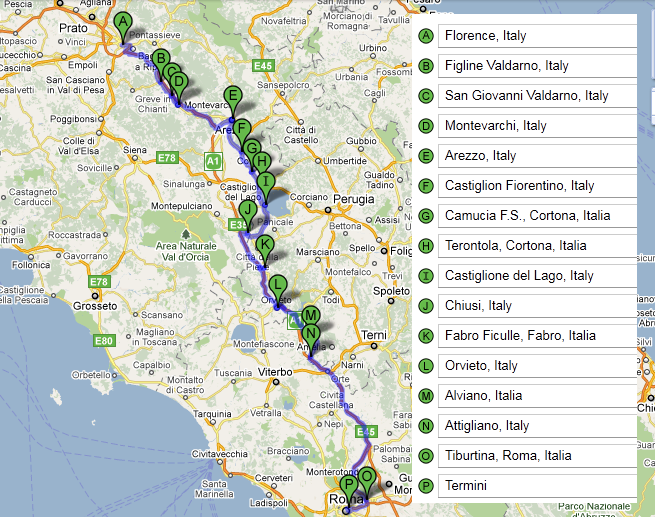
Train Route and Stops: Florence to RomeGoogle Map |
It seems that we have organized our lives for the next seven months. When we first came to Florence we thought that we might go on to Sicily and from there start a tour of Italy. But we fairly frequently scan Craigslist to see what's available and we found what looked like a good place for us in Rome. After about ten days of back-and-forths we came to an agreement with the owner and will stay in her Rome apartment from April 29 to July 1. Unusually for us, it is not an owner-occupied one-time-sublet but rather an owner sometimes-occupied, often-sublet place. The owner is based in Los Angeles and just uses her Rome studio-apartment part of the year and rents it out other times.
We'll take our bicycles with us. For that reason we've selected a slow train, which allows them. The fast train only takes about 90 minutes (Florence is 250 km from Rome) but our slow train is preferable as what we'll see from the window won't all be a flash. We'll stop at about 15 stations and Gerry has already mapped them out.
In Rome we'll start by going about with our Paris friend, Veronica, who's coming to Rome specifically to observe the beatification of defunct Pope John-Paul II. We expect to have a good guide in her. She'll go away for three weeks and then will return to the city, walking the last 20 km of the Via Francigena, the ancient pilgrimage route from Canterbury. (She's previously done the entire route on foot.) We'll join her for the last part, perhaps 10 km. What else we'll do in Rome we don't know yet, except for the obvious biggies like the Sistine Chapel, the Vatican Museum, the Ancient Roman sites, etc., etc. Rome, after all, is where the Roman treasures we just saw at the Pitti came from.
Then it's wander about time again, in what will be our first time in a year of nightly or nearly nightly changes of abode. (We left Japan last June 24; we'll leave Rome this July 1.) We'll work our way north from Rome through, we expect, Assisi (of St Francis), Ravenna (three stars according to Michelin), Milan (also 'trois etoiles'), and Turin. Each should be a 3-4 hour train trip, punctuated by 1-3 nights stay. Maybe we'll even drag our bicycles along. We'll be on our way to visit friends in Embrun (just across the alps in France from Turin) and then Yvonne and Sandro in Henau, in northeastern Switzerland. From there we'll be off for another stay in Paris at Veronica's place. That will be our sixth time; when we leave at the end of October we'll have spent 18 months there. Consequently this time in Paris most places we go will be returns to familiar haunts. And that goes for politics; the French presidential race (voting to be held in May, 2012) will be heating up and we hope to go to lots of election rallies.